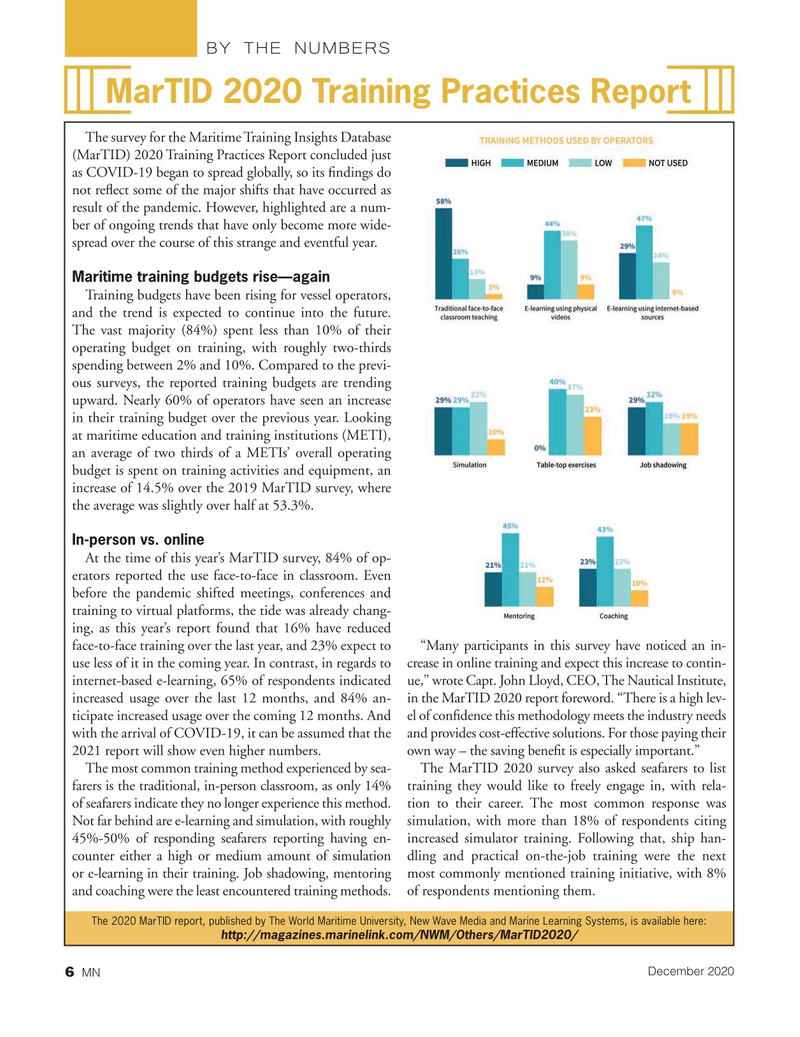
Page 6: of Marine News Magazine (December 2020)
Innovative Boats & Products
Read this page in Pdf, Flash or Html5 edition of December 2020 Marine News Magazine
BY THE NUMBERS
MarTID 2020 Training Practices Report
The survey for the Maritime Training Insights Database (MarTID) 2020 Training Practices Report concluded just as COVID-19 began to spread globally, so its ? ndings do not re? ect some of the major shifts that have occurred as result of the pandemic. However, highlighted are a num- ber of ongoing trends that have only become more wide- spread over the course of this strange and eventful year.
Maritime training budgets rise—again
Training budgets have been rising for vessel operators, and the trend is expected to continue into the future.
The vast majority (84%) spent less than 10% of their operating budget on training, with roughly two-thirds spending between 2% and 10%. Compared to the previ- ous surveys, the reported training budgets are trending upward. Nearly 60% of operators have seen an increase in their training budget over the previous year. Looking at maritime education and training institutions (METI), an average of two thirds of a METIs’ overall operating budget is spent on training activities and equipment, an increase of 14.5% over the 2019 MarTID survey, where the average was slightly over half at 53.3%.
In-person vs. online
At the time of this year’s MarTID survey, 84% of op- erators reported the use face-to-face in classroom. Even before the pandemic shifted meetings, conferences and training to virtual platforms, the tide was already chang- ing, as this year’s report found that 16% have reduced face-to-face training over the last year, and 23% expect to “Many participants in this survey have noticed an in- use less of it in the coming year. In contrast, in regards to crease in online training and expect this increase to contin- internet-based e-learning, 65% of respondents indicated ue,” wrote Capt. John Lloyd, CEO, The Nautical Institute, increased usage over the last 12 months, and 84% an- in the MarTID 2020 report foreword. “There is a high lev- ticipate increased usage over the coming 12 months. And el of con? dence this methodology meets the industry needs with the arrival of COVID-19, it can be assumed that the and provides cost-effective solutions. For those paying their 2021 report will show even higher numbers. own way – the saving bene? t is especially important.”
The most common training method experienced by sea- The MarTID 2020 survey also asked seafarers to list farers is the traditional, in-person classroom, as only 14% training they would like to freely engage in, with rela- of seafarers indicate they no longer experience this method. tion to their career. The most common response was
Not far behind are e-learning and simulation, with roughly simulation, with more than 18% of respondents citing 45%-50% of responding seafarers reporting having en- increased simulator training. Following that, ship han- counter either a high or medium amount of simulation dling and practical on-the-job training were the next or e-learning in their training. Job shadowing, mentoring most commonly mentioned training initiative, with 8% and coaching were the least encountered training methods. of respondents mentioning them.
The 2020 MarTID report, published by The World Maritime University, New Wave Media and Marine Learning Systems, is available here: http://magazines.marinelink.com/NWM/Others/MarTID2020/
December 2020 6 MN

 5
5

 7
7
